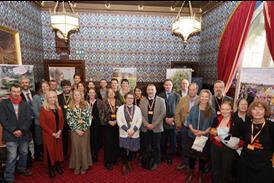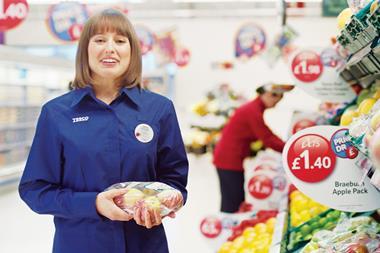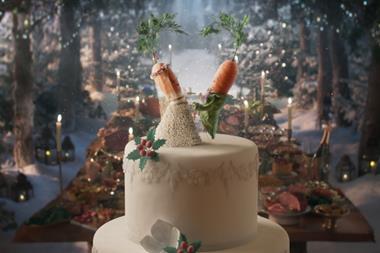Novelty: taste is not an issue as the yuck factor takes off
Bugs, slugs and bags of ooze keep Sarah Hardcastle busy as she explores a growing niche market
N early a century ago, the confectionery market throbbed with innovation and new product development. The UK's small confectionery companies thought nothing of bringing out 20 or more completely new products every year, bringing real excitement to the market.
Things are rather different now. With so much investment riding on every development, manufacturers have become a lot more cautious about creating something radically new, preferring the relative safety of brand extensions and me-too products.
Many manufacturers take the view that most of the flavour/ ingredient/ texture combinations have been tried and the successful formats have been established, leaving little room for further exploration.
Despite this conservatism, innovation is still very much alive and kicking in the small, but growing niche market of novelty confectionery. Here, the focus of creativity isn't the taste side of things most products use conventional chocolate and sugar confectionery but in wonderfully clever and inventive presentation and packaging. The concepts and designs range from amusing but squeamish chocolate bugs, slugs and caterpillars, to the ultimate in luxury gifting exquisite silk bags containing a handful of gold foil chocolate coins plus a host of entertaining keepsake items for children, like Rugrats dinosaur money boxes filled with candy bones.
Gifting of one sort or another is the principal market for these items, with Christmas and Easter being the peak sales periods. But as consumer demand is growing, the sales opportunities for these items are increasing.
Petty,Wood began supplying confectionery novelties about five years ago and is now seeing its sales rise 30% year on year, says confectionery sales manager Brian Dean.
The company specialises in fun chocolate products like the slightly risqué Monkey Nuts and The Chippendales' male torsos, plus a range of canned brains, worms, slugs, maggots and squashed hedgehogs which are hugely popular with children.
"The more disgusting the idea, the more kids love it," says Dean. "Worms and bugs are our bestsellers. Headless chickens has been a big hit and reindeer noses, which we're doing for Christmas, looks like its going to do well."
Next year it wants to take the yuck' factor further with products that ooze. "We're looking at white chocolate worms with green fondant ooze or brains with red ooze. Ooze is a hit in the US," says Dean.
The company also does joke items such as a realistic looking chocolate pizza decorated with cherries and a Russian roulette game with a hot chilli chocolate bullet for the unlucky loser.
"All these products are bought as fun gift items, selling purely on their novelty appeal. Price is never an issue and tends to be premium, the cans retailing from £1.99 to £2.50 depending on outlet.
"Sales are seasonal but we're now looking to branch out into non-seasonal occasions like birthdays," adds Dean.
Petty, Wood creates its ideas in conjunction with manufacturers and retailers who want own label. Dean says there's constant pressure to come up with fresh concepts because the lifespan of a novelty product is very short.
This is an issue that taxes the ingenuity of every manufacturer in this marketplace. Key account manager David Hill of Van Lauren, a leading supplier of sumptuously packaged Belgian chocolate novelties, reckons four years is the maximum his company can get out of each concept. "In the first year a design will be exclusive to the retailer we've created it for.
"In the second, when exclusivity has expired, we'll offer it to others in different colours. In the third, we'll export it and in the final year, it'll be discounted."
Van Lauren has seen the trend for novelty confectionery grow over the last five years, led by upmarket department stores such as Selfridges.
"It's growing because it offers added value that's lacking in traditional boxed chocolates. Our sales in this area are increasing between 10% and 15% a year," says Hill.
Van Lauren's range takes luxury gifting to new heights with designs that include green tea truffles in a dim sum box, a chocolate CD for St Valentine's Day and spoons filled with Irish liqueur flavoured chocolate for stirring into coffee. It also does foil-wrapped chocolate animal strips of outstanding quality from the US and mug gift sets filled with marshmallows and sachets of drinking chocolate or coffee beans.
Hill says the mug sets are its best- sellers. Sugar novelties include spooky yellow, orange and black designs for Hallowe'en. Hill says Hallowe'en is becoming an increasingly important gifting occasion, driven by huge interest in Europe.
He believes sales opportunities for confectionery novelties are increasing because the sales period is getting longer.
"It starts in autumn when Christmas gifts start to go in and carries on until late spring with Mother's Day, which has become a gifting occasion."
Van Lauren creates its designs in-house and works with retailers and department stores to produce own label and bespoke novelties.
An emerging trend is to incorporate a store's seasonal colour schemes into the designs. Its Stanley range of traditional confectionery can be personalised in small quantities for the independent sector.
The majority of confectionery is sourced in Europe and the US, while the packaging components come from the Far East.
Under its own brand, Van Lauren has just introduced the Diffusion range which includes finger puppets with sweets and ethnic bags with luxury truffles, in vibrant shades of red, orange and pink.
"Colour is a big selling point in novelty confectionery and a new livery can often extend a product's life," says Hill.
With demand growing, price points are rising. Van Lauren's chocolate foil animal stick packs sell between £1.99 and £2.99, its green tea truffles from £3.79 to £4.99 and its 200g fruit bucket of fudge from £2.49 to £3.49.
One of the fastest growing areas of the novelty business and the confectionery market as a whole is character confectionery. Bon Bon Buddies claims to be the leader with an international market for its licensed properties that include Rugrats, Noddy, Pokémon, Simpsons and PowerPuff girls.
A start-up company nearly seven years ago, its business is growing 50% annually. Children's increasingly sophisticated demands for new, exciting and entertaining products is fuelling this phenomenal growth, says director Pauline Howarth.
"Children want the very latest merchandise for the major brands and characters. It's a fashion-based business and fashions change all the time and kids can lose interest. But with strong analysis, market research and good forecasting and understanding of the youth market, we increase the likelihood of backing the winners," says Howarth.
Its winning formula invariably includes a keepsake, such as the Rugrats' Angelica jewellery case filled with candy beads and pendants, PowerPuff girls shoulder tin with milk chocolate eggs and marshmallows and Pokémon Pikachu moneybox with milk chocolate balls which are in its Christmas and Easter ranges.
"The keepsake value of the product is really important for successful appeal," says Howarth. "It has to offer interactivity, complete synergy with the character, the ability to encourage pester power', and it must be filled with desirable novelty confectionery."
Howarth says the average lifespan for a product based on a topical character is two to three years, while those based on classic characters such as Noddy and the Simpsons have indefinite staying power. Its Rugrats line, one of its bestsellers, has been going for six years.
The company also does a range of very successful licensed and branded chocolate and sugar confectionery games, such as Monopoly, Connect, Pictionary and Trivial Pursuit. It claims to be global leader in this area.
All concepts are originated in-house by Bon Bon Buddies development team, with all production outsourced to UK and Far Eastern suppliers to maintain flexibility.
Howarth says the range has wide distribution in all the major high street and grocery multiples and specialist outlets, as well as in the US, Europe and Australia.
"Christmas and Easter are our main selling periods, but we see all year round as the massive growth area," says Howarth.
{{FOCUS SPECIALS }}
Close menu
- Home
- Retail & Wholesale
-
Products & Suppliers
- Back to parent navigation item
- Products & Suppliers
-
Product Categories:
- Back to parent navigation item
- Product Categories:
- Alcoholic drinks
- Bakery
- Cereals & breakfast
- Cheese
- Chicken & poultry
- Chocolate
- Confectionery
- Crisps, nuts & snacks
- Dairy
- Fish
- Fresh produce
- Frozen
- Household
- Meat
- Own Label
- Sauces & condiments
- Seasonal
- Soft drinks
- Vaping
- Vegan & plant-based
- World foods
- Suppliers
- People
- Reports & Data
-
Topics A-Z
- Back to parent navigation item
- Topics A-Z
-
Popular topics:
- Back to parent navigation item
- Popular topics:
- Cost of living crisis
- Crime
- Deposit Return Schemes
- Finance
- Government & Regulation
- Health
- Inflation
- Loyalty
- Marketing
- Mergers & Acquisitions
- New Product Development
- Sourcing
- Supply chain
- Sustainability & environment
- Technology
- Ultra Processed Foods
- Vaping
- A-Z all topics
- Content by type:
- Events
- Ask iA (beta)
- Subscribe now
Sign in to comment on this article
Not logged in before? Register for FREE guest access today.
You will be able to:
- Read more stories
- Receive daily newsletters
- Comment on stories
Advert















No comments yet